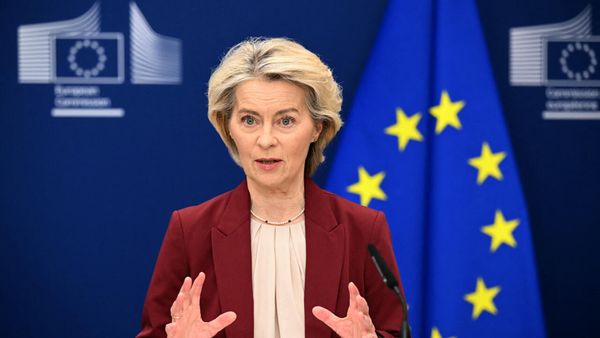
Stevlana Mutkevych’s busy Monday morning was interrupted with powerful blasts that rocked and roiled Kyiv.
“I heard three. One made the house shake,” the 64-year-old nurse told Al Jazeera.
Her apartment building is close to the Bessarabsky Market, a fortress-like landmark in central Kyiv named after a region czarist Russia conquered after repelling the 1812 Napoleonic invasion.
These days, Moscow’s military might is minuscule in comparison with its heyday — especially after a string of humiliating defeats and withdrawals from Ukraine’s north, east and south.
That’s why Monday’s blasts in Kyiv and 11 other cities throughout Ukraine seem to have one purpose — to sow panic among Ukrainians, officials say.
Russian President Vladimir “Putin’s only tactic is terror on peaceful Ukrainian cities, but he will not break Ukraine down”, Dmytro Kuleba, Ukraine’s foreign minister, said in a tweet.
Explosions across Kyiv
The explosions Mutkevych heard occurred less than two km (one mile) from her home in central Kyiv.
At least one more district in Kyiv and three sites in the Kyiv region have been hit. Authorities reported at least 10 people dead and dozens wounded across the nation, but the death toll is expected to rise.
Photos posted on social media and news websites show firefighters next to burning cars, civilians wounded and gaping holes in buildings and roads. One hole was in the middle of a children’s playground.
Many expect the shelling to continue after months of calm in Ukraine’s capital.

Mutkevych spent the first three nights of the war, which started on February 24, in the subway station near her house.
It was jam-packed with women trying to calm crying babies, men smoking nervously and elderly residents who often had no mattresses or chairs and slept on the granite floors.
Later, Mutkevych occasionally hid in the basement of her apartment building, but it was crammed with used furniture and construction materials and had no heating or electricity.
“It was damp and dark, we were freezing there,” she said. “My arthritis got worse.”
Then she — as well as hundreds of thousands of other people living in Kyiv — ignored air raid sirens, sarcastically calling them “lullabies” as the threat of deadly attacks eased.
Unlike on Monday, Russia did not shell central Kyiv in the first weeks of its invasion. Instead, it primarily targeted the city’s outskirts and a military plant where advanced weaponry is manufactured.
“We concluded that Putin wanted to keep downtown intact because he wanted to be there for a military parade” on May 9, the anniversary of the Soviet victory over Nazi Germany, Mutkevych said.
But the parade never took place, and by late March, Russian forces withdrew from around Kyiv and four more northern regions, leaving behind thousands of civilians they are accused of torturing, maiming, raping and killing.
Bomb shelters in Kyiv were mostly empty – until Monday.
Adding to the danger are the targets of Monday’s attacks. The Russian shelling hit civilian infrastructure that millions of urban residents depend on, observers said
“They will try to hit as many civilian infrastructure sites as possible – power stations, central heating [generators] and so on,” Kyiv-based analyst Ihar Tyshkevich told Al Jazeera.
Ukraine’s prime minister says 11 civilian infrastructure sites in Kyiv and eight other regions were damaged on Monday morning.
“One has to get ready for temporary interruptions of electricity, water supply and [cell phone] communication,” Denys Shmygal said on Telegram.
Crimea bridge blast
Putin said the renewed shelling is revenge for Saturday’s attack on the Crimean Bridge, which links the annexed peninsula to mainland Russia.
Kyiv has not directly claimed responsibility for that blast, but some officials have celebrated the attack on a key supply line for Moscow’s troops.
Putin on Monday warned of more “harsh” attacks.
At a meeting of Russia’s Security Council, he said: “A massive strike was carried out with long-range, high-precision air, sea and land-based weapons on Ukraine’s energy, military command and communications facilities.
“If attempts to carry out terrorist attacks on our territory continue, Russia’s responses will be harsh and, in terms of their scale, will correspond to the level of threats posed to the Russian Federation. No one should have any doubts about this.”
The bridge was Putin’s pet project. It spans 19km (12 miles) across the Kerch Strait, cost billions of dollars and symbolises Russia’s hold on Crimea, a Soviet-era riviera with subtropical flora and sandy beaches.
The style of shelling seen on Monday is all Russia’s military is capable of today, analyst Tyshkevych said.
“Yes, this is revenge, but this is what Putin can afford for now,” he said. “Russia has no chances of quickly changing the situation on the front lines.”
Russia most likely used strategic bombers, cruise missiles and Iranian-made Shaheed “kamikaze” drones, military analyst Alexander Kovalenko said in televised remarks.
The use of such assorted weaponry more than 48 hours after the Crimean Bridge attack means Russia does not have much left in the way of arms, he said.

“This looks more like the enemy’s convulsions, [as they hit] with the remaining weapons,” he said.
Another military analyst said Russia laid the political groundwork for the attacks a week and a half ago.
Russia’s annexation of four Ukrainian regions on September 30 led the Kremlin to claim it had a right to use weapons of mass destruction (WMD) to defend “Russian” territory, Lt Gen Ihor Romanenko, former deputy chief of the General Staff of Ukraine’s Armed Forces, told Al Jazeera.
“Within the framework of the Russian legislation, Putin has the right to use the WMDs,” he said.
The annexation, which was widely condemned internationally as illegal and meaningless, coincided with the panicked flight of thousands of Russian soldiers from the northeastern region of Kharkiv.
Since then, Ukrainian forces have advanced in parts of neighbouring Donetsk and Luhansk. The latter had been almost fully seized in early July.
Both southeastern regions, known collectively as Donbas, had been partially controlled by pro-Russian separatists since 2014 when a Russia-instigated conflict erupted, displacing millions of people and killing more than 13,000.
In recent weeks, Ukraine also recaptured a swath of the strategic southern region of Kherson, which borders annexed Crimea.
“We are capable of moving on,” Romanenko said.
However, Ukrainian forces are engaged in “very heavy defence” fighting in other parts of Donetsk, where Moscow has concentrated its offensive, he said.
Most everyday Ukrainians are adamant their country will prevail.
“Like hell he will see us grovel at his feet,” Mutkevych said through tears, referring to Putin.
“I will live to see the day of our victory when he is carried out of the Kremlin feet first.”







